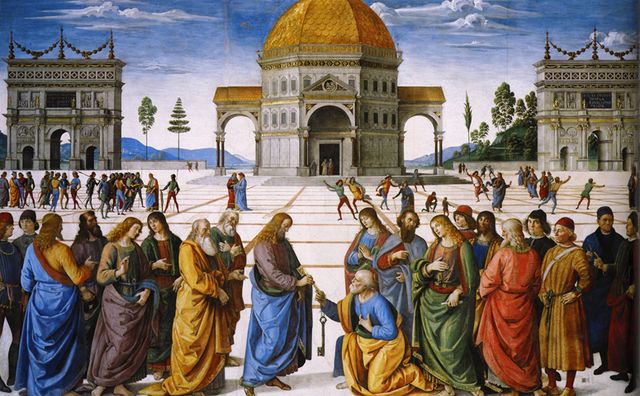
Solemnity of Saints Peter and Paul, Apostles
Peter confesses the true identity of Jesus in a pivotal moment of understanding: He was the Savior who was to ransom Israel, redeeming the world from the power of sin and death.
Gospel according to Matthew 16:13-19
When Jesus went into the region of Caesarea Philippi he asked his disciples, “Who do people say that the Son of Man is?” They replied, “Some say John the Baptist, others Elijah, still others Jeremiah or one of the prophets.” He said to them, “But who do you say that I am?” Simon Peter said in reply, “You are the Christ, the Son of the living God.” Jesus said to him in reply, “Blessed are you, Simon son of Jonah. For flesh and blood has not revealed this to you, but my heavenly Father. And so I say to you, you are Peter, and upon this rock I will build my Church, and the gates of the netherworld shall not prevail against it. I will give you the keys to the Kingdom of heaven. Whatever you bind on earth shall be bound in heaven; and whatever you loose on earth shall be loosed in heaven.”

Reflections
Today is the celebration of two of the most prominent leaders of the early Church: Saint Peter and Saint Paul. These two holy men came from entirely different backgrounds: Peter, or Kephas, the son of Jonah, was a robust, impetuous, and experienced fisherman who awaited the coming of the Messiah. (1) Methodical and practical about commanding a fleet of fishing boats stationed in Capharnaum on the shores of Lake Tiberias, the Sea of Galilee, Peter first met Jesus through his brother, Andrew, who was a follower of John the Baptist. Andrew introduced Peter to Jesus, who called them to become his disciples: “Follow me, and I will make you fishers of men!” (Matthew 4:19). Leaving family, boats, and occupation behind, they “left everything” to follow Jesus (Matthew 19:27). During the next three years, Peter came to learn from Jesus and became a new man. Jesus “…transformed him from an uneducated and even fearful man into a courageous and faithful apostle who became instrumental in the establishment of the Church.” (1)
Paul of Tarsus, or Saul, as he was known prior to his conversion, was Jewish from the tribe of Benjamin, with a dual roman and Jewish citizenship, inherited from his father. (2) He is thought to have been born around the same year as Jesus. (2) Educated in Jerusalem under the famous Rabbi Gamaliel, he was a zealous pharisee who witnessed and approved the stoning of the first martyr after Jesus’ resurrection, Saint Stephen. Saul was still ardently persecuting the first Christians when Jesus met him on the road to Damascus and called him to convert and become one of His disciples. Relying on his skills in tentmaking, Paul left his position as a pharisee and joined the Christian community in Damascus. From there he travelled “over 10,000 miles” on missionary trips to Cyprus, Asia Minor, Greece, Jerusalem, Syria and the eastern Mediterranean region, all the way to Malta and Rome in modern day Italy, part of the former Roman Empire. (3)
The way these two men traversed vastly different trajectories to understand Jesus’ message and to proclaim it in Jerusalem and beyond, in Rome, where both of them died as martyrs because of their faith, is interesting to ponder since they represent the different ways in which people come to believe. Looking back at his journey, Paul wrote that “God…set [him] apart from [his] mother’s womb and called [him] by his grace” (Galatians 1:15). Familiar with the Greek, Roman, and Jewish cultures, language, and customs, versed in philosophy, he was ideally suited for a life of mission to distant lands to proclaim the Gospel to Jews and Gentiles and was chosen by God with the instructions to Ananias, the leader of the Church in Damascus: “Go, for he is an instrument whom I have chosen to bring my name before gentiles and kings and even before the people of Israel; I myself will show him how much he must suffer for the sake of my name’” (Acts 9:19). Saul would have “rejected the view that Jesus had been raised after his death—not because he doubted resurrection as such, but because he would not have believed that God chose to favor Jesus by raising him before the time of the Judgement of the world.” (2) In other words, he would not have accepted Jesus as the Messiah and the Son of God. When he answered with a “yes” to God’s call, which he perceived vividly for the first time, Saul accepted a radically new idea, which changed his life forever. To mark his conversion, he used the name which he received in Baptism: Paul. (2)
Peter was already a follower of Jesus, part of the Twelve, when Jesus posed the question: “Who do people say that I am?” (Matthew 16:15). This was the first point of entry into various levels of understanding. Some through Jesus was the reincarnation of the spirit of John the Baptist. Some thought he was a prophet who came back to life, such as Elijah or Jeremiah, or some other prophet. The prophets were revered as messengers of God who were sent to communicate the will of God to the people. They were spokespersons for God, sent to prepare the way and the hearts of the people to receive the Messiah—the Savior. (5) They always pointed ahead of them at the Messiah. This was one of the ways in which one could distinguish the false prophets from the true prophets: the false prophets pointed at themselves; and the true prophets pointed to preparing the path of the Messiah. The false prophets reveled in their finite moments of glory; the true prophets suffered persecution, and their lives were in constant danger. Many of them were put to death. (6) So, when Jesus asks the disciples the next question, “But who do say that I am?” (Matthew 16:15), he poses them a more intimate question: “You who are my followers, what do you say about me?” This question poses a pinnacle of the revelation of the truth deep within their hearts: “What do you say about me?” When Peter quips: “You are the Christ, the Son of the living God” (Matthew 16:16), he confesses Jesus to be not a prophet, but God, the Son of God, the Messiah. This confession of Peter was a pivotal moment to declaring Jesus’ true identity and the disciples understanding the nature of Jesus’ mission. He was the Savior who was to ransom Israel; redeem the world from the power of sin and death. (7)
In his blessing of Kephas, and giving him the name, Peter, Petros, the Rock, Jesus affirms the title Christ and Son of God and declares that only God the Father through the Holy Spirit could have revealed this to Peter, for this happened before Jesus explicitly revealed himself as the Christ to the disciples. In fact, in the account of Mark 8:27, Jesus strictly forbade the disciples to talk to anyone about this: he “…strictly charged them to tell no one about him.” In chronological order, Jesus invited the disciples, taught them in parables, miraculously healed the sick, restored life, fed five thousand people and another time four thousand, calmed the storm, walked on water, and learned about the death of his cousin, John the Baptist, after which the demands from the pharisees and the scribes has intensified about giving them a sign by whose authority he is performing these miracles. Thus, it is the pinnacle of Jesus’ ministry when he confirms his identity and establishes Peter as the leader of the Apostles and of the Church and promises that “the gates of Hades will not prevail against it.” (Matthew 16:18). From this time on, Jesus begins to prepare his disciples for his suffering and death. This will be followed by the resurrection, according to God’s plan of salvation.
The young church suffered trials and persecutions. First, by the hands of the non-believers, such as Saul of Tarsus, who was an enemy of the Church until his miraculous conversion. Later, at the hands of tyrants, such as Nero and Caligula, during whose reign Christins were killed in the colosseum. Presently, the church still suffers at the hand of those who do not comprehend that the paths of God are non-violent. In addition, there are human errors, mistakes of judgement, or differences of opinion which make the life of the Church challenging. Despite these realities, Jesus’ words remain written in the hearts: In the face of mistakes; one can resolve to do better; in the face of death and vulnerability; one can focus on the relevance of the moment; in the face of suffering, one can cling to hope.
We all come from different backgrounds, and all have a journey of faith, during which the same question reverberates: “And you, who do you say that I am?” While Jesus blesses Peter for an answer that was revealed to him by the Spirit, He does not condemn those who do not have a well-formulated answer. He meets us where we are in our stage of development and understanding and walks with us toward seeking and finding answers to this fundamental question which, as we see from the examples of Saints Peter and Paul, can have such a profound influence on a person’s goals and direction.
References
- Dexter, J. (2025). Peter Character Study Podcast. Retrieved from: www.studyandobey.com/character-studies/peter-character-study/ Accessed; June 25, 2025.
- Britannica (2025). St. Paul the Apostle. Retrieved from: www.britannica.com/biography/Saint-Paul-the-Apostle. Accessed on: June 25, 2025.
- Loyola Press (2025). Paul’s Journey. Retrieved from: www.loyolapress.com. Accessed: June 25, 2025.
- McDowell, S. (2018). Why did Jesus tell his disciples to be silent about his identity? Retrieved from: www.seanmcdowell.org. Accessed: June 25, 2025.
- Hawkswell, V. (2023). The law, the prophets, and the Church. Retrieved from: www.bccatholic.ca Accessed: June 25, 2025.
- Goh, W. (2025). Discerning True Prophets. Homily – 25 June 2025. You Tube. Roman Catholic Archdiocese of Singapore.
- Catechism of the Catholic Church (2025). Sections 430-435. Retrieved from: www.catholiccurlture.org. Accessed: June 25, 2025.